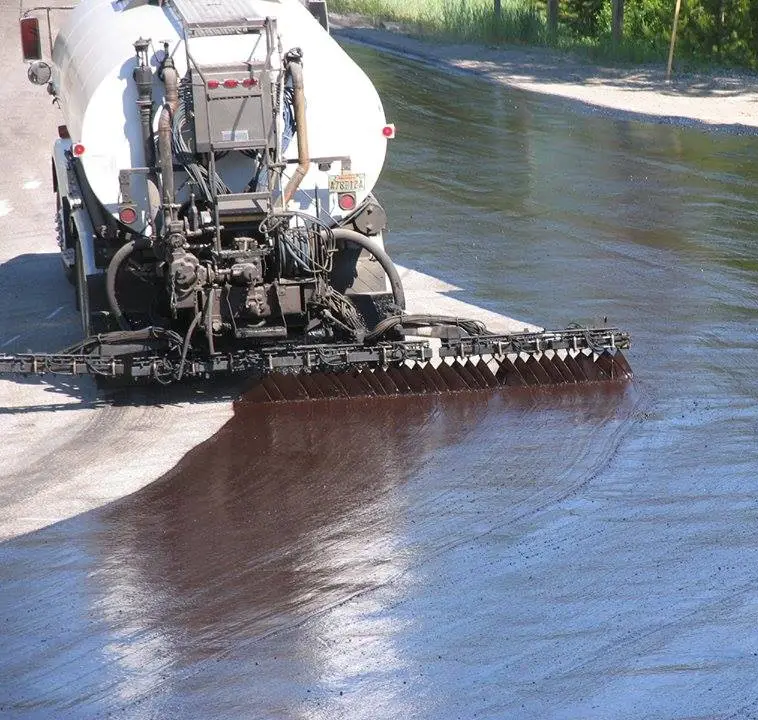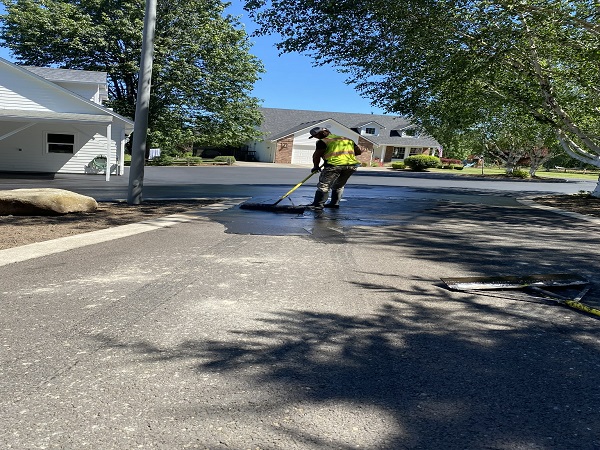Sealcoating
If you’re a commercial building owner, sealcoating is essential to maintaining the longevity and integrity of your asphalt pavement. Sealcoating acts as a protective layer that shields against weather damage and other environmental factors. It also gives your asphalt surface a clean new finish – no matter how old or worn it may be. But there’s more to this process than meets the eye; from preparing for the job to curing and maintaining afterward, learn about sealcoating in this comprehensive guide.

Applying the Sealcoat Material
Choosing the right equipment for application is essential to a successful sealcoating job. A pressure washer should clean the surface and remove dirt, debris, or oil stains. The type of nozzle used will depend on the material being applied; a wide-angle fan spray tip is best for asphalt sealer, while a pencil jet nozzle works better with crack fillers. Choosing an applicator that evenly spreads the sealcoat material over the entire surface area is also essential. Professional grade machines such as ride-on squeegees are recommended for large jobs, but smaller jobs can be done with hand-pumped tank sprayers or garden pump sprayers.
Calculating coverage rates and mix ratios is critical in achieving an even finish without wasting materials. Sealcoating typically covers between 200 and 400 square feet per gallon depending on the porosity of the surface and the thickness desired, so it’s important to measure out your space accurately before purchasing supplies. Mixing ratios vary depending on manufacturer instructions but generally range from 4 parts water to 1 part asphalt emulsion for general-purpose sealcoats and up to 8 parts water to 1 part asphalt emulsion for heavy-duty applications like airports and highways where more durability is required.
Now it’s time to focus on curing and maintaining your asphalt surface after sealcoating to extend its life.
Troubleshooting Common Issues with Sealcoated Asphalt Surfaces
Taking the bull by the horns and exercising due diligence guarantees that their asphalt surface will remain safeguarded from wear and tear for years. Through proper preparation before application, ensuring only compatible high-quality materials are used, thoroughly cleaning the surface before applying primer, and closely following manufacturer instructions when mixing and applying seal coat, key components of preventing future problems with adhesion or flaking can be achieved.
Frequently asked questions
Sealing a driveway is an integral part of asphalt maintenance. It helps to protect the surface from water damage, UV rays, and oxidation. First, cleaning the surface thoroughly by removing dirt and debris with a pressure washer or broom is essential. Then apply a brush or roller sealer in thin coats until the entire driveway has been covered. Allow each coat to dry before applying additional layers for best results. Finally, please wait 24 hours before driving on the newly sealed driveway so that it can cure properly and last longer.
Sealcoating your driveway is a great idea. Sealcoating serves as a safeguard for the asphalt, helping to preserve it from wear and tear and water damage. The sealcoat acts as an extra layer of protection for the asphalt, helping it last longer and remain in better condition over time. Additionally, sealcoating can help improve the appearance of your driveway by giving it a smooth finish that enhances its aesthetic appeal. In short, sealcoating is an effective way to maintain and preserve your driveway while improving its overall look.
Sealcoating can be dangerous if not done correctly. It is essential to use the correct type of sealer for the specific asphalt surface and follow all safety precautions when applying it. Ventilation is necessary when utilizing a solvent-based sealer to avoid breathing in toxic fumes or contact with skin that can cause burning and discomfort. Additionally, any chemicals used during application should always be handled carefully and stored safely away from children and pets. Lastly, extreme caution should also be taken while working around traffic, as it can create hazardous conditions for workers and motorists.

Sealcoating
Sealcoating is an integral part of asphalt maintenance and should be noticed. Applying a sealcoat can provide lasting protection for your asphalt, safeguarding it from the environment and ensuring its longevity and aesthetic appeal. With proper preparation, application, curing, and regular maintenance, you can ensure that your sealcoat job will provide long-term protection for your asphalt surface. Remember sealcoating; taking care of it now could save you money.
Let Black Magic Asphalt care for all your asphalt maintenance needs, from patchwork to potholes and crack filling to sealcoating and striping. Our experienced professionals are ready to provide you with the highest quality service at an affordable price.
Equipment selection and mix ratio calculations are essential for a successful sealcoating job. Professionals should ensure they have the right gear on hand to cover their desired surface area while also using manufacturer-recommended water and asphalt emulsion ratios to get the job done correctly without cutting corners.
